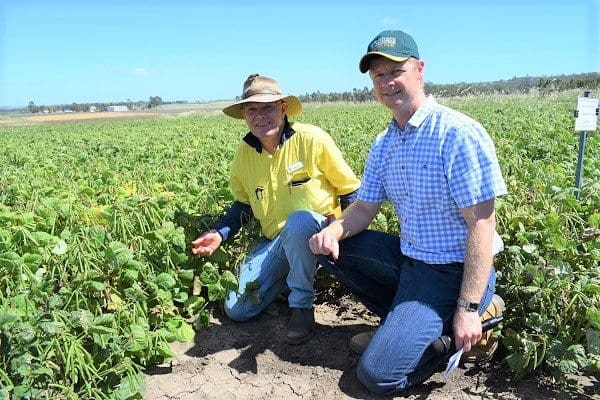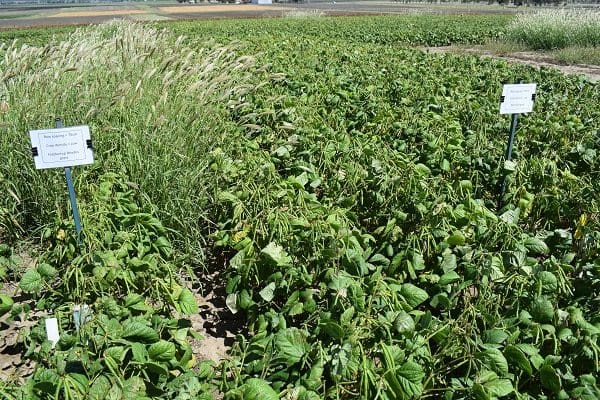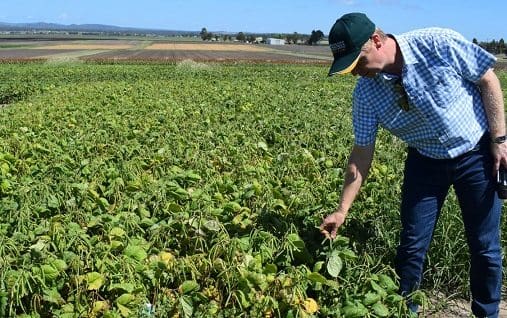SOWING crops on narrow row spacings is proving a powerful, non-chemical strategy for harnessing crop competition to minimise the weed burden in trials in southern Queensland.

Queensland Department of Agriculture and Fisheries senior experimentalist, Greg Harvey, and principal research scientist, Michael Widderick, in row spacing trials at Hermitage Research Station, Warwick.
Queensland Department of Agriculture and Fisheries principal research scientist, Michael Widderick, said researchers were 18 months into a five-year project looking at row spacing and crop density as a weed management tool in mungbean, faba beans, chickpeas, sorghum and wheat.
Speaking at the Australian Mungbean Association field walk at the Hermitage Research Station near Warwick on Queensland’s Darling Downs yesterday, Dr Widderick said in mungbeans the work had focused on the impact of row spacings on the difficult-to-control summer weeds, feathertop Rhodes grass and awnless barnyard grass.
Trials had been set up at Hermitage with mungbean crops sown on three different row spacings (25 centimetres, 50cm and 75cm) and two crop densities (20 and 35 mungbean plants per square metre). Feathertop Rhodes grass and awnless barnyard grass seeds were sown in different plots to test the extent of weed development.
“Generally, what we are seeing is narrow row spacing of 25cm is suppressing the number, biomass production and seed production of feathertop Rhodes grass and barnyard grass, whereas the wide row spacing of 75cm allows those weeds to grow readily and produce large quantities of seed in-crop,” he said.
“We haven’t yet taken measurements to see the impact on weeds of crop density.
“Generally, what we are finding in other crops is that row spacing will have the greater impact and crop density a lesser impact on weeds.”

Mungbeans sown on 75cm row spacings showing weed competition from feathertop Rhodes grass (left) and barnyard grass (right).
Dr Widderick said the aim of using crop competition as a weed management tactic was to create conditions that favoured the crop rather than the weeds.
The technique also offered a non-chemical means of weed control that helped in the fight against the rising incidence of herbicide resistance.
“We are heavily reliant on herbicides for weed management, both in-crop and in fallow. But, as a result of an over-reliance on herbicides, there is now a large number of cases of herbicide resistance across multiple weed species,” he said.
“So, it is a real turning point in terms of conservation agriculture and weed management. A lot of our research is now focussing on non-chemical approaches for weed management. One of those is crop competition.
“We are also doing work on harvest weed seed control and looking at targeted and strategic tillage.”
Dr Widderick said feathertop Rhodes grass and barnyard grass had developed resistance to glyphosate and had not always been effectively controlled with the herbicide.
He said no resistance to Group A herbicide had yet been detected, “but it is only a matter of time”.
“I would say that in the next two to three years we will have the first cases of Group A resistance in feathertop Rhodes grass and barnyard grass. So, this is where crop competition allows us to use something that is non-chemical to combat these weeds,” he said.
The GRDC-funded trial is being conducted by the Queensland Department of Agriculture and Fisheries (QDAF) and the University of Queensland (UQ).
Grain Central: Get our free daily cropping news straight to your inbox – Click here


HAVE YOUR SAY